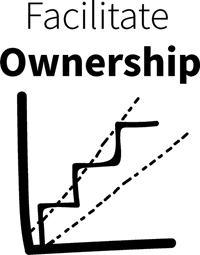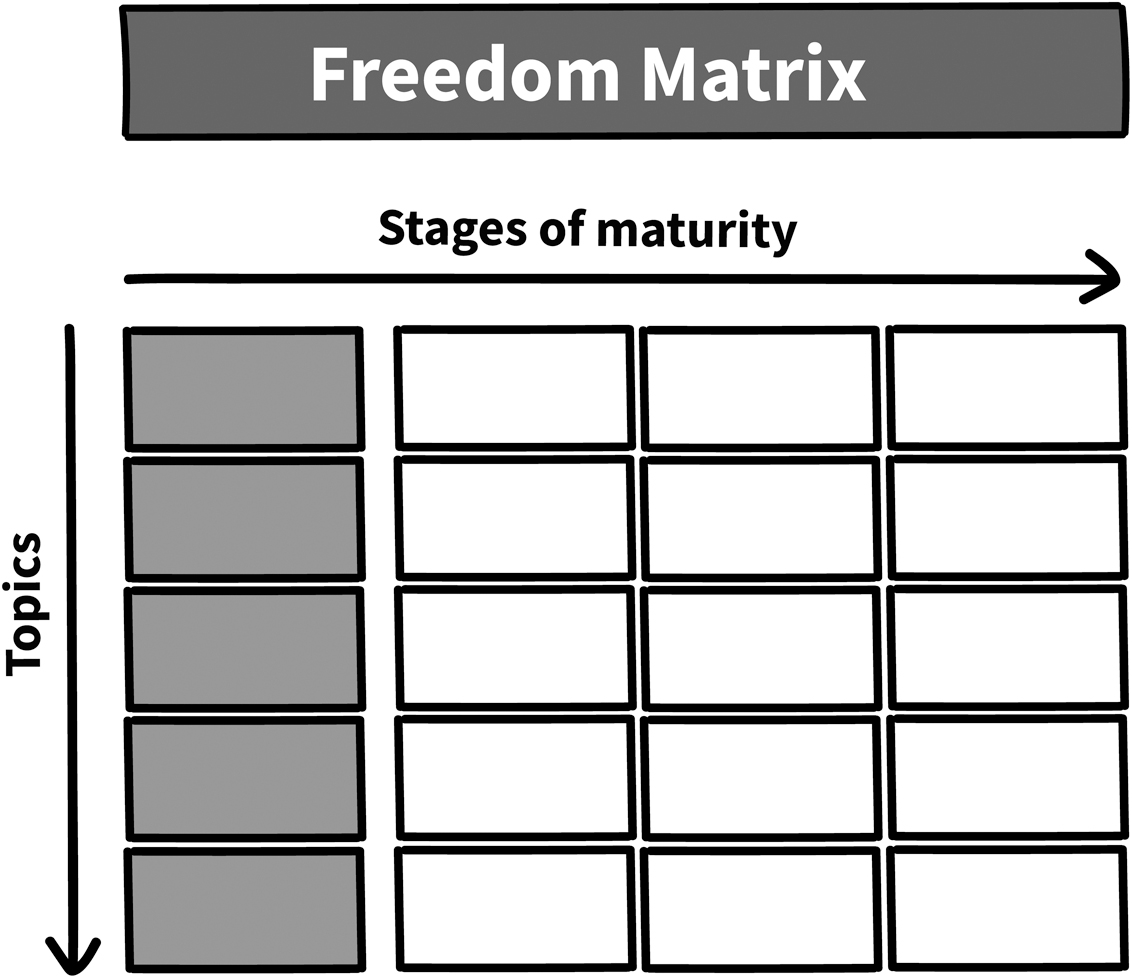2.5 How Can the Borders be Aligned With the Maturity?
Because we all agreed to drive on the right side of the road (as in, not on the wrong side of the road ![]() ), stop for a red light, and respect the speed limit, we actually increase the freedom and autonomy!
), stop for a red light, and respect the speed limit, we actually increase the freedom and autonomy!

Introduction Questions
1. How much freedom can highly mature teams get from you in the end?
2. Which borders are needed to increase the freedom and autonomy in your teams?

Mature teams need broader and fewer borders than teams who are just starting. To maximize ownership in teams, the agile leader must allow the borders to expand with maturity. But what are the right borders? What are concrete examples of broader freedom? Are there such mature teams that they have complete and total freedom? Or do self-managing teams still need borders?
Concretely Expanding the Borders
By expanding the borders in steps, the agile leader creates clarity for the team. It is important that the borders remain clear and that the steps are transparent, so there must be several steps between zero freedom, whereby the agile leader prescribes matters, to complete freedom, whereby the team can independently determine and regulate everything. A first step might be that the team brainstorms with the manager but that the manager still makes the decision; the next step might be for the team and the manager to come to a decision together; a further step might be that the team itself makes a decision after the supervisor has been consulted; a final step might be that the team does not even have to inform the manager about the choice. This is a concrete and practical approach to gradually broaden the borders.
Freedom is different for each topic or theme. There are topics in which even a starting team is given a lot of freedom and others where even a high-maturity team has little freedom. For example, a starting team can often arrange their own holiday planning and a high-maturity team cannot give themselves an unlimited salary increase. For topics such as improvement budgets, team composition, and assessment, clear borders are required that grow with maturity. In practice, it is often difficult to determine freedom for these kinds of themes. This is because, on one hand, a topic must be split into subjects, and on the other, the expectations of freedom differ from person to person. Precisely for this reason, the fourth tool of the toolkit has been developed: the Freedom Matrix. I will first explain how themes can be split and then I will explain the Freedom Matrix.
Theme Example 1: Team Composition
Freedom around the theme “team composition” is difficult to make concrete because it consists of various topics. For example, there is the hiring of team members on the basis of a vacancy, changing team members between two or more teams, contracting an external employee, and dismissing an employee. The freedom on each of these facets has to be determined for each stage of maturity. For example, a starting team can probably change team members but can’t yet autonomously hire new members based on a vacancy. The team only gets this freedom when they are more mature. The question is whether it is wise to give a highly mature team the freedom to fire a colleague.
Theme Example 2: Rating
The freedom surrounding the evaluation and assessment of employees also consists of several subjects—for example, informal feedback, a positive evaluation, a negative evaluation with consequences, and the determination of the bonus split or salary increase. It’s wise to make the freedom for each stage of maturity on each of these topics concrete. It is good when a starting team immediately learns to give each other feedback. Some highly mature teams determine—given a fixed budget—the distribution of the bonus and the salary increase among themselves.
Tool 4: Freedom Matrix
Boundaries must be tangible, and freedom must gradually increase as team maturity increases. A tool that helps with this is the Freedom Matrix. This tool is based on the Delegation Board from Management 3.0, developed by Jurgen Appelo.2 The Freedom Matrix makes the connection between the maturity of the team and the freedom the team receives on specific topics. By doing this, this fourth tool of the agile leadership toolkit makes it clear which freedoms the team gets when. As a result, expectations about freedom become explicit and can be discussed and improved. The Freedom Matrix looks like Figure 2.4.
2. https://management30.com/practice/delegation-poker/

Figure 2.4 The Freedom Matrix
Horizontal Axis: Stages of Maturity
As mentioned, the stages of maturity could be designated as junior, medium, and senior teams, or 1-, 2-, and 3-star teams.
Vertical Axis: Topics
A separate row is used for each of the concrete subjects. These can be topics as mentioned earlier: changing team members between teams, giving informal feedback, or releasing an external employee.
Cells: Freedoms
In the cells, freedom is clearly stated on a subject at a given stage of maturity. This freedom has been split into steps or levels. This way, teams can gradually gain more freedom during their growth.
The supervisor decides and informs the team about this.
After brainstorming with the team, the supervisor makes the decision.
After brainstorming, the manager and the team decide jointly.
After brainstorming with the manager, the team decides.
The team decides and informs the manager about the decision.
The team decides, and the manager is not actively informed.
Freedom does not always have to be increased with a growth in maturity; it may be wise to keep freedom the same. A starting or junior team may also be given the highest degree of freedom immediately.
Example of a Freedom Matrix
Figure 2.5 is an example of a Freedom Matrix.

Figure 2.5 Example Freedom Matrix
In this example, a Junior team gets freedom 3 for handling the interviews for new team members. This means that they have to consult their manager and ask his advice prior to making a decision. A Medium team can interview, filter, and choose new team members based on a vacancy themselves. They only have to keep their leader informed of the final decision.
Next, they get a quarterly $2,000 investment budget. A Junior team still has to ask the manager for advice prior to spending the budget. Medium and Senior teams only have to inform their manager on how they spent it.
Firing of team members is still done by the manager. For a Junior team, the manager just tells why he has fired a person. For more mature teams, the manager brainstorms or consults with the team prior to making the decision.
In this example, the team gets a quarterly bonus. For a Junior team, the manager divides the bonus. But a Senior team can decide themselves on how to divide the bonus. The manager only tells the team the amount of bonus they can divide among themselves.
